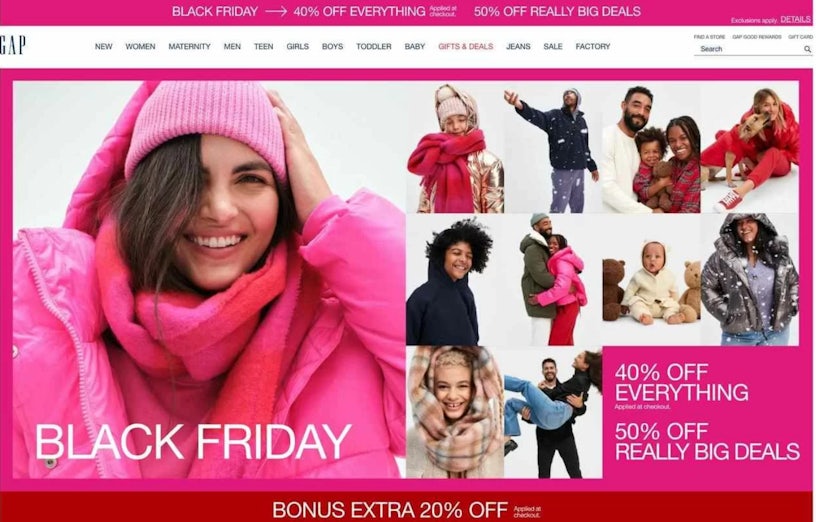Black Friday, historically known as the year’s biggest shopping event, rolls around each year, and marketers prepare months ahead for the increased activity.
The UK is one of the biggest ecommerce markets in the world, however, reports have been mixed regarding the industry’s performance so far in 2024. Industries such as men’s fashion have seen a decline since the beginning of the year, while health & beauty retailers have reportedly seen significant growth. Brands that cover multiple categories can learn from this by reviewing these industry trends and investing more in the sectors that are performing well.
Last year, Cyber Weekend accounted for 25% of total sales for November in the UK, while eCommerce revenue also increased by 6.94% YoY on Black Friday. This suggests that despite the turbulent economy, shoppers are waiting for the Black Friday period to make use of big savings.
It’s been reported in previous years that Black Friday is no longer a single-day event and that held true in 2023. Consumer spending started increasing from the 11th of November last year, highlighting how far in advance shoppers are starting their spending to reflect a more drawn-out sales season throughout November.
Here we detail how marketers can best prepare for the upcoming peak season, along with our learnings from previous years.
Key dates
October:

Paid media: Now is the ideal time to begin your campaign to generate anticipation and capture early shopper interest. Your middle and bottom funnel audiences should be established through your activity in August and September. By the time the sales roll around, you want to have already educated your audience and warmed them up to what you have to offer. You will then be able to use retargeting ads to bring in prospects who are ripe for making a purchase.
Whatever offer you choose, it’s important to note that the cost per 1,000 impressions (CPM) will increase around the Black Friday/Cyber Monday push. Bundles, however, can be an excellent strategy for increasing the average order value (AOV) to keep your ROI high. Be mindful of last year’s activity and analyse its results to see how you can optimise your offers and ads for greater success this year.

SEO: Get your house in order. Your key existing pages should be identified at this stage and new content uploaded to fill gaps in your taxonomy compared to your competitors.
Make sure things like your mega nav contains key pages for Black Friday, Cyber Monday and other holiday pages. Make sure this is all indexable in search.

Digital PR: Journalists will likely have been publishing requests for Black Friday deals since August and at this stage the preparation for any Digital PR activity should be underway. Whether your ecommerce brand is outreaching the products that will be reduced in price around Black Friday, or you’re building a bigger campaign, October is a key time to refine the content and begin preparing your media lists.

UX: Now is the time to ensure your website is prepared for additional traffic. If your Black Friday marketing campaigns are successful, you can expect to see increased traffic to your site, however, if your website isn’t capable of handling such traffic levels, you risk losing sales. Review the current speed of your site making any necessary changes, and reduce reliance on your own server in order to improve load speeds and make your website more resilient. Additionally, you could consider moving to a cloud-based server setup, whereby the requests can be balanced across multiple servers rather than relying on just one.
November:

Paid media: At this stage, the unexpected can happen and you may have to pivot your strategy, especially in response to your competition. Regularly monitor your competitors through website checks, rising term tracking, social listening and other tools. If competitors are outperforming you or rising CPCs hinder visibility, be ready to increase media spend. Secure a backup budget well in advance to ensure you’re not scrambling mid-campaign. Additionally, plan for alternative offers, ensure team coverage, and manage stock levels carefully to avoid running out of key products. Having these contingency plans will help you adapt and stay competitive on the day.
Now is also the time to implement countdown ads, to create urgency and drive conversions. These ads highlight the limited time remaining until your sale or special offers begin, encouraging shoppers to act quickly. Start running these ads a few days before Black Friday to generate excitement and ensure your brand stays top of mind. Make them customised to the viewer’s time zones if you operate an international website so the ad shows during the whole day for those customers. Be sure to monitor their performance closely and adjust bids or creative elements to maximise impact as the countdown progresses.

SEO: Monitor commercial & traffic metrics to understand any quick opportunities or insight for next season. Continue to look at the data you’re seeing via Google Search Console or other third-party tools to identify if there are any quick wins to be made. Implement seasonal content, like gift guides or sale previews, that align with what shoppers are searching for. Use schema markup to highlight deals, reviews, and product availability in search results. Monitor rankings and competitor activity closely, adjusting on-page elements and content as necessary. Lastly, review and refine your internal linking structure to direct traffic to high-priority pages and boost overall site engagement.

Digital PR: November is the time to outreach to your media lists, focusing on those already covering Black Friday such as shopping editors and lifestyle writers. Cutting through the noise will be key to capturing journalists’ attention.
Aligning your Digital PR strategies with key dates throughout the year is a great idea. Recognising the content that’s most likely to land at various points such as Black Friday, Christmas, Valentine’s Day, Halloween and so on is an important step to being relevant and useful to journalists.
But that only works if you have something valuable to contribute to that ‘hook’. If not, you’re at risk of actually being unhelpful – and losing relationships that would otherwise benefit you in the future. Be sure to consider this when crafting your strategy.

UX: Learning exactly what your users will respond to before Black Friday will give you a big advantage. Use data and learnings to shape your key Black Friday landing pages and messaging, split testing messaging around discounts and deals can lead to better conversion rates come Black Friday weekend.
For example, some customers respond better to percentage discounts, others to numerical values – so “25% off” vs “Save £50”. Some prefer added value deals over discounts, so consider what you can offer, such as ‘free shipping’ or an additional product with purchase.
Peak shopping times unpacked
Analysing our data from previous years, we can spot changing consumer trends around purchase trends during peak seasons and predict what businesses should expect this year.
Last year, Brits made 9.92 million transactions during Black Friday, a 2 percent increase from the previous year.
The biggest lift in traffic YoY came on the Friday before Black Friday, when traffic shot up 63% YoY—from 32 to 52 million sessions.
The key sectors that benefited from this activity were:
- Electronics – 53% (1.3 billion visits)
- Apparel & Accessories – 16% (386 million visits)
- Health & Beauty – 12% (290 million visits)
- Food – 6% (156 million visits)
- Toys & Hobbies – 4% (87 million visits)
- Home & Appliances – 3% (75 million visits)
- Department store – 3% (71 million visits)
- Other (jewellery, hardware & home improvement, auto parts, sporting goods and more – 3% (71 million visits)
Analysing our client data we’ve been able to assess the peak times for traffic throughout the day on Black Friday within the UK.
It appears consumers begin opening websites at 5am with impressions and clicks seeing sudden increases by 7am. This figure then stagnates and in some cases decreases towards lunchtime, before reaching its highest peak at 6pm.
Being aware of these sudden increases and monitoring each year allows you to prepare in advance and anticipate which deals to push year on year.
Last year’s data also showed that residents in Greater London spent the most on Black Friday, averaging over £181, followed by Wales and the West Midlands. In contrast, those in the South West were likely to spend the least.
Understanding this data is key to building effective targeting strategies. Knowing where to boost ads, amend deals and win over customers is key to a successful Black Friday.
How an effective website can maximise conversions
Anticipating and preparing for peak season sales takes a layered approach, with multiple moving pieces, it’s essential to step into the mind of the customer to create an enticing buying experience.
With intensifying competition, the visual impact of a website could make all the difference in retaining user attention and converting traffic into sales.
However, how can you improve website sales in peak periods using psychological principles?
Inspire action with focused content
Websites aiming to make sales during the peak period often fall into the trap of overdoing the sales messaging, especially on key landing pages.

Human attention is limited, with the average human attention span lasting 8.25 seconds, so to ensure potential customers can focus on elements that inspire action when they land on your page. These elements are usually imagery and copy highlighting the benefit of your service or product to the user.

For optimal landing page design, use contrasting colours and negative (empty) space around focus areas of the website that will draw eyes to the most important content. This tactic highlights motivators for users like discounts or calls to action (CTA), e.g. click here buttons.
Be wary of using animations. If you plan on incorporating moving images, ensure you do so thoughtfully and carefully to prevent a spike in cognitive overload (mental exhaustion). Users can get fatigued if overloaded with things to look at on a page, and decreasing the visual fluency of the page can result in lost customers.
Carefully consider if a carousel is needed before adding to a hero (top of a page). Ask yourself if the information could be presented instead as an easy-to-digest message that motivates users without overwhelming them.
Frame your message
When a room is too loud, all conversation is drowned out, and you end up hearing nothing. The same is true visually. If there is too much to look at on a webpage, users tune out and don’t focus on anything. So, it is imperative that landing pages pushed during the peak period are clear and direct. As much as you want to make offers to be clear, you do not want to overwhelm users with multiple flashing banners and text that splits their attention.

Creating a simple but compelling value proposition on a webpage is no easy feat and should be approached with research and the willingness to experiment. The tactics you implement when creating your messaging and CTAs will depend on products and service offerings. Brands with a seasonal or specific product urgency will work, e.g. buy now before it’s gone. For other brands that offer more expensive or higher-end items, exclusivity and playing on consumer egos may appeal best with a more subtle approach, e.g. make their Christmas special.
When pushing upsells, highlight the user benefit with reference pricing such as: was £20 is now £15 or add this for just £1 more, etc.
Soak imagery in emotion
Seeing is believing, and imagery is vital to pushing sales. People will not buy things they haven’t seen first, so having high-quality pictures on your website is vital. To take your imagery to the next level, try incorporating emotion to help users connect with and invest in the product you are selling. If possible, try utilising human faces in your imagery using models. Humans look to others to understand how we feel, so having a model interacting with your product can subconsciously push users to hit buy.
If you already use models on your website and have data on the ones connected with more sales and most popular with users, try using them for items being pushed in peak periods. Customers have already established emotional connections with these models, and their recognisability could stimulate trust and familiarity for shoppers, leading them to purchase.
Leverage motivation and reward
Take a good look at your customer base, analyse their previous behaviours and segment them into groups, tailoring specific rewards.
At this point, you may find it appropriate to offer benefits to loyal customers, reaching out with incentives to entice previous customers back to your website. Experiment with automatically applying discounts to the website and making users aware of this as they land on the page.
Tap into customer intrinsic and extrinsic motivation, leveraging emotional benefits, feeling special for receiving unique offers, with extrinsic motivation, being compelled by the physical cost savings.
Draw the maximum amount of attention to any cost savings in the checkout. If favourable, leverage the delivery cost and time, setting a fixed amount to achieve free delivery and increase basket values.
Keep it simple
People are looking for convenience, so remove any friction from your checkout process and consider ways to make it easier to increase basket values. This could be through personalised upsells in baskets or related product pop-ups when a customer adds a product to their basket.
For more actionable tips and strategic advice on getting your brand ready for this Black Friday and peak sales period, check out our Q4 peak selling season guide or get in touch with our team.





